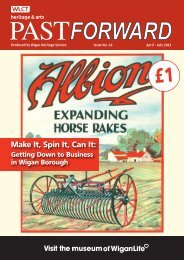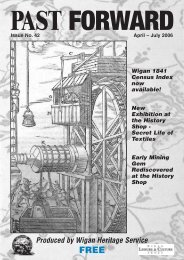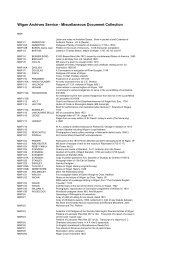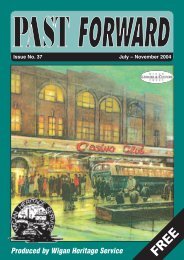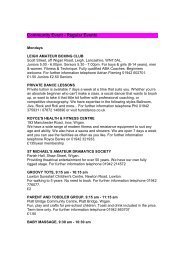A Royal Celebration - Wigan Leisure and Culture Trust
A Royal Celebration - Wigan Leisure and Culture Trust
A Royal Celebration - Wigan Leisure and Culture Trust
Create successful ePaper yourself
Turn your PDF publications into a flip-book with our unique Google optimized e-Paper software.
14<br />
discover who knocked Lizzy up. She wore rubber<br />
irons which weren’t too noisy but when she rattled<br />
on doors <strong>and</strong> windows that was another story.<br />
Soon after Lizzy the clatter of clogs started, slowly<br />
at first, rising to a deafening crescendo I guess<br />
around 7.00am. Outside of the busiest time it was<br />
sometimes possible to recognise individual footfalls<br />
<strong>and</strong> some of these would be an accurate indicator<br />
of time, especially when ‘t’pegleg’ went past.<br />
It could be an urgent call if Mam shouted:<br />
“T’pegleg’s gone past”, meaning you might be late<br />
for school. I think his name was Tom <strong>and</strong> as the<br />
nickname implies, he had a wooden leg <strong>and</strong> wore a<br />
clog on the other foot giving a distinctive clack,<br />
thump, clack, thump, clack, thump as he passed.<br />
I believe he lived in Whelley <strong>and</strong> worked at the<br />
forge in Ince.<br />
The clatter of clogs was greatly muffled in times of<br />
snow, but this created another problem. Snow<br />
tended to ball-up under the ball of the foot <strong>and</strong><br />
sometimes added another three or four inches to<br />
ones height – useful for a shorter fellow like me<br />
but it was a bit like walking on stilts <strong>and</strong> created<br />
problems of balance. Kicking a foot against the<br />
wall of a house was a useful way of removing the<br />
resulting ‘pad’ for a few yards but the continuous<br />
thump, thump of clog against wall could become<br />
more disconcerting than the usual clack, clack. The<br />
compacted lumps of snow left on the ground<br />
could become dangerous weapons for the more<br />
irresponsible lads during snowball fights.<br />
Clogs themselves could become formidable<br />
weapons but, though fights were common in the<br />
schoolyard, fists were still the weapon of choice<br />
<strong>and</strong> I never remember clogs being used. I did once<br />
see a poor coalman given a ‘porrin’ for being<br />
suspected of delivering ‘one bag short’ but even<br />
then the assailant aimed at a less vulnerable part of<br />
his anatomy - they were gentle people who lived in<br />
Scholes! My Dad told me that older men had told<br />
him of serious clog-fighting taking place around<br />
<strong>Wigan</strong> with betting <strong>and</strong> prize money at stake.<br />
There is no better description of clog fighting than<br />
can be found in the novel ‘Rose’ by the famous<br />
American writer Martin Cruz Smith, set in <strong>Wigan</strong> in<br />
the 1870s. How he found <strong>Wigan</strong> after placing his<br />
best known novel, Gorky Park, in Moscow, I will<br />
never know. They were never ‘weapons of mass<br />
destruction’ but clogs may have gone to war. An<br />
old retired miner friend of mine once told me of<br />
leaving <strong>Wigan</strong> Drill Hall at the start of World War<br />
One wearing pit-clogs. He marched with the 5th<br />
Manchester Regiment through <strong>Wigan</strong> <strong>and</strong> over the<br />
Iron Bridge to <strong>Wigan</strong> North West station – what a<br />
noise that must have made. He said that they also<br />
wore dress uniforms as there were no khaki<br />
uniforms available at the time. I often wonder if<br />
they went to France dressed like that <strong>and</strong> what<br />
would Jerry have thought.<br />
I used to think that clogs were unique to<br />
Lancashire but I now know that they were worn<br />
all over the north of Engl<strong>and</strong> <strong>and</strong> in Wales. Clog<br />
dancing, once a popular form of entertainment,<br />
probably a forerunner of tap but in recent years<br />
practised mainly by certain Morris dancing<br />
troupes, seems to be making a comeback. I knew<br />
that all-wooden clogs (French: sabots) were<br />
popular in Europe <strong>and</strong> are still worn by some<br />
country people in Brittany. However I was<br />
surprised to find, talking to an old lady now living<br />
in the south of France but originally from Paris,<br />
that they wore wood <strong>and</strong> leather clogs which,<br />
according to her description, were exactly like<br />
ours. I have since seen them in a museum in the<br />
south of France. They were called galôches but<br />
were no different than the clogs we wore.<br />
Vive le Clog!



